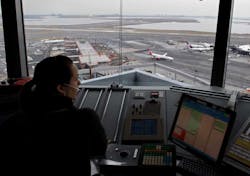Delays Worse After JFK Runway Work Done
Jan. 27--Flight delays at Kennedy Airport have worsened since the completion of a $376 million runway reconstruction project that officials had vowed would ease air traffic problems, according to U.S. Department of Transportation statistics.
When construction began in March 2010, officials said the revamped Runway 13R-31L would reduce flight delays by cutting the time planes spent traveling to and from the gate by up to a minute, or an estimated 10,500 hours a year.
But since the runway reopened in July 2010, the percentage of late arrivals and departures has increased.
Arrivals delays increased from 19 percent between Oct. 1, 2009, and March 1, 2010, to 20 percent during the same period a year later, statistics show.
Departure delays also rose. About 18 percent of all flights that took off from October 2009 to March 2010 were delayed. Departure delays increased to 19 percent during the same time frame a year later, the numbers show.
The percentage of arrival and departure delays from June to November of last year continues to be higher than before the reconstruction began.
'An inflated statistic'
Steve Abraham, the president of the National Air Traffic Controllers Association at Kennedy Airport, said that while some of runway work, like a new taxiway, has made his job easier, the notion that the improvements would yield 10,500 hours of delay reduction was hard to believe.
"It sounds like an inflated statistic," Abraham said.
The Port Authority and the Federal Aviation Administration could not explain the increase in delays and said the runway reconstruction work, redesigning the airspace around New York, including adding departure routes, and a switch to satellite navigation are all changes made to cut down on flight delays.
"These efforts have already produced operational benefits for the three major airports," the FAA said in a statement.
Jerry Spampanato, Kennedy's general manager of aviation, said airport officials believe they've reduced delays.
"I've been at the airport a long time," Spampanato said. "I can recall delays at this airport going on still at 1 or 2 o'clock in the morning. I can't recall, other than weather, when we've had peak delays after midnight [recently]. . . . We don't control the airspace. We control what's on the ground."
The Northeast's crowded airspace may be the explanation for the continued delays, officials said.
"You'd like to be able make improvements at one airport and say I'm going to get all this improvement," said Kevin Mitchell, chairman of the Business Travelers Coalition, an advocacy group for corporate travel managers. "You can't because you're going to be impacted by the overall airspace."
Vaughn Cordle, an analyst with AirlineForecasts Llc and a retired airline pilot, has said delays can be eased at airports like Kennedy if airlines chose to fly larger planes that carry more people instead of offering more flight options to customers using smaller jets.
"Do they really need 30 flights a day from cities outside New York?" Cordle said.
Delays have gotten longer
Besides the percentage of delayed flights increasing, the length of the delays also have risen. From Oct. 1, 2009, to March 1, 2010, average arrival delays were 2.45 minutes. A year later, they had more than doubled to 5.9 minutes. For departing flights, the average departure delay increased from more than 9 minutes to more than 11 minutes, statistics show.
These increases occurred as the number of domestic flights at Kennedy decreased by about 500 total flights in the same time span.
Fights are considered on-time if they depart from the gate or arrive at the gate less than 15 minutes after their scheduled departure or arrival times, according to the Bureau of Transportation Statistics.
Delays, which only are measured for domestic flights, can be caused by variety of factors, including air carrier decisions, aircraft spacing, security and extreme weather.
Despite the increase in delays, Kennedy Airport has improved when compared with other U.S. airports.
While Kennedy used to rank at or near the bottom for on-time performance among major U.S. airports, according to federal records, the most recent statistics, from last November, show the airport ranked in the middle of the pack.
Jeff Zupan, a senior transportation fellow with the Regional Plan Association, said the Port Authority needs to build an additional runway at Kennedy to meet forecast demand for air travel and to help alleviate the delay problem.
"They may have tried to make the case that it was a capacity and delay issue," he said. "They may have oversold it."
Copyright 2012 - Newsday, Melville, N.Y.
